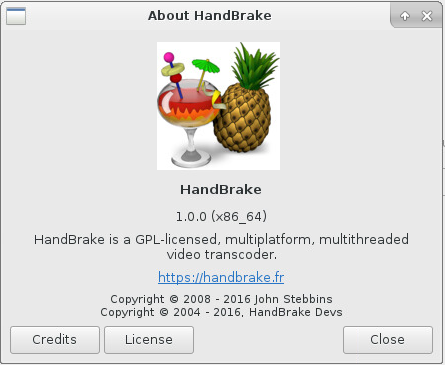 I wanted to have the last 16.08.x release of KDE Applications available in my repository before the new 16.12.x releases start coming. There are some big changes in Applications 16.12 for which I need to time to review, plan and build packages. Therefore you will probably not see packages for Applications 16.12.0 in 2016.
I wanted to have the last 16.08.x release of KDE Applications available in my repository before the new 16.12.x releases start coming. There are some big changes in Applications 16.12 for which I need to time to review, plan and build packages. Therefore you will probably not see packages for Applications 16.12.0 in 2016.
So, my december release of the ‘ktown’ packages – KDE 5_16.12 – is sporting KDE Frameworks 5.28.0, Plasma 5.8.4 and Applications 16.08.3 for Slackware, built on top of Qt 5.7.0 which was recompiled with a patch which should improve stability. You can use the latest KDE 5 on Slackware 14.2 and -current.
And because there’s some people who do not read my posts all too carefully, let me again state strongly: my repository contains “latest” and “testing” releases. Currently, the “testing” release is severely outdated and will probably not work at all, or at a minimum give you headaches. The repository you are downloading from should either have “14.2/latest” (for Slackware 14.2) or “current/latest” (for Slackware -current) as part of the URL. When I have time and feel confident, I will re-visit the “testing” repository and work on the Wayland support, which is what that repository is meant for.
Be sure to check your automated package management programs for the correct repository URL!
What’s new in KDE 5_16.12?
This upgrade should be straightforward if you already have Plasma 5 installed. See below for install/upgrade instructions. And if you want to check it out before installing, I have generated a new Live ISO for the PLASMA5 variant. Look for that ISO on http://bear.alienbase.nl/mirrors/slackware-live/latest/ soon. Check the timestamp of the “slackware64-live-plasma5-current.iso” ISO.
Installing or upgrading Frameworks 5, Plasma 5 and Applications
You can skip the remainder of the article if you already have my Plasma 5 installed and are familiar with the upgrade process. Otherwise, stay with me and read the rest.
As always, the accompanying README file contains full installation & upgrade instructions. Note that the packages are available in several subdirectories below “kde”, instead of directly in “kde”. This makes it easier for me to do partial updates of packages. The subdirectories are “kde4“, “kde4-extragear“, “frameworks“, “kdepim“, “plasma“, “plasma-extra“, “applications“, “applications-extra” and “telepathy“.
Upgrading to this KDE 5 is not difficult, especially if you already are running KDE 5_16.11. You will have to remove old KDE 4 packages manually. If you do not have KDE 4 installed at all, you will have to install some of Slackware’s own KDE 4 packages manually.
What I usually do is: download all the ‘ktown’ packages for the new release to a local disk. Then run “upgrade –install-new” on all these packages. Then I check the status of my Slackware-current, upgrading the stock packages where needed. The slackpkg tool is invaluable during this process of syncing the package installation status to the releases.
Note:
If you are using slackpkg+, have already moved to KDE 5_16.11 and are adventurous, you can try upgrading using the following set of commands. This should “mostly” work but you still need to check the package lists displayed by slackpkg to verify that you are upgrading all the right packages. Feel free to send me improved instructions if needed. In below example I am assuming that you tagged my KDE 5 repository with the name “ktown” in the configuration file “/etc/slackpkg/slackpkgplus.conf“):
# slackpkg update
# slackpkg install ktown (to get the newly added packages from my repo)
# slackpkg install-new (to get the new official Slackware packages that were part of my deps previously)
# slackpkg upgrade ktown (upgrade all existing packages to their latest versions)
# slackpkg upgrade-all (upgrade the remaining dependencies that were part of my repo previously)
And doublecheck that you have not inadvertently blacklisted my packages in “/etc/slackpkg/blacklist“! Check for the existence of a line in that blacklist file that looks like “[0-9]+alien” and remove it if you find it!
Recommended reading material
There have been several posts now about KDE 5 for Slackware-current. All of them contain useful information, tips and gotchas. If you want to read them, here they are: http://alien.slackbook.org/blog/tag/kde5/
A note on Frameworks
The KDE Frameworks are extensions on top of Qt 5.x and their usability is not limited to the KDE Software Collection. There are other projects such as LXQT which rely (in part) on the KDE Frameworks, and if you are looking for a proper Frameworks repository which is compatible with Slackware package managers such as slackpkg+, then you can use these URL’s to assure yourself of the latest Frameworks packages for Slackware-current (indeed, this is a sub-tree of my KDE 5 repository):
The same goes for Frameworks for Slackware 14.2 (change ‘current’ to ‘14.2’ in the above URLs).
Where to get the new packages for Plasma 5
Download locations are listed below (you will find the sources in ./source/5/ and packages in /current/5/ and /14.2/5/ subdirectories). If you are interested in the development of KDE 5 for Slackware, you can peek at my git repository too.
Using a mirror is preferred because you get more bandwidth from a mirror and it’s friendlier to the owners of the master server!
Have fun! Eric
 Christmas creates a different focus for the average IT guy, spending time with family instead of computers. It was nice. But it’s over and done now, even though the Christmas tree in the corner of our living room is still on fire (metaphorically speaking).
Christmas creates a different focus for the average IT guy, spending time with family instead of computers. It was nice. But it’s over and done now, even though the Christmas tree in the corner of our living room is still on fire (metaphorically speaking).





Recent comments